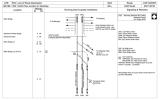Note: the thread has become general XC chat for the late 80s and 90s, partly down to myself I admit, so I've edited the subject to reflect that. Basically the idea of the thread is any discussion on XC post-sectorisation and during early privatisation, but prior to the introduction of Voyagers.
Follows on a bit from the current thread on "broken Britain" services into Liverpool from over the Pennines but, having been thinking quite a bit about the "classic" XC era (the 'loco-hauled and HST' era, up to early Virgin) recently, I'm wondering when, and why, XC lost most of its Liverpool services.
For most of the 80s Lime Street had a two-hourly service to Birmingham by XC, with many services then extending to the SE or SW. In some years this was an exact clockface pattern, in others less regular.
From around 1987 to 1995 I stopped following XC, before regaining interest around the time of privatisation. By then, XC Liverpool services were much more restricted: there was a daily Poole-Liverpool and return (out morning, back afternoon). The latter service, the southbound afternoon Liverpool-Poole was one of the longest-standing individual XC services, with a history going back to at least 1978. There was also, IIRC, an afternoon Reading-Liverpool which was the return working of the Edinburgh-Reading which ISTR was notable for being worked occasionally by D9000 "Royal Scots Grey". This must have presumably have had a balancing working, presumably in the morning out of Liverpool.
The majority of the services out of Liverpool at this time towards Birmingham were operated by Central Trains. It was however more frequent at (IIRC) hourly.
So at some point between 1987 and 1995, but not sure when, the majority of Liverpool-Birmingham must have transferred from the IC sector to the RR sector - and the through services to the SE and SW were largely lost.
The question is, why? My theory would be that there was a desire for a more frequent service to Birmingham but insufficient XC stock for IC to continue to run it. RR had enough stock and so they took it over.
The other question is when? In 1986 I remember there were still plenty of XC Liverpools but by Virgin days these had been drastically reduced.
Follows on a bit from the current thread on "broken Britain" services into Liverpool from over the Pennines but, having been thinking quite a bit about the "classic" XC era (the 'loco-hauled and HST' era, up to early Virgin) recently, I'm wondering when, and why, XC lost most of its Liverpool services.
For most of the 80s Lime Street had a two-hourly service to Birmingham by XC, with many services then extending to the SE or SW. In some years this was an exact clockface pattern, in others less regular.
From around 1987 to 1995 I stopped following XC, before regaining interest around the time of privatisation. By then, XC Liverpool services were much more restricted: there was a daily Poole-Liverpool and return (out morning, back afternoon). The latter service, the southbound afternoon Liverpool-Poole was one of the longest-standing individual XC services, with a history going back to at least 1978. There was also, IIRC, an afternoon Reading-Liverpool which was the return working of the Edinburgh-Reading which ISTR was notable for being worked occasionally by D9000 "Royal Scots Grey". This must have presumably have had a balancing working, presumably in the morning out of Liverpool.
The majority of the services out of Liverpool at this time towards Birmingham were operated by Central Trains. It was however more frequent at (IIRC) hourly.
So at some point between 1987 and 1995, but not sure when, the majority of Liverpool-Birmingham must have transferred from the IC sector to the RR sector - and the through services to the SE and SW were largely lost.
The question is, why? My theory would be that there was a desire for a more frequent service to Birmingham but insufficient XC stock for IC to continue to run it. RR had enough stock and so they took it over.
The other question is when? In 1986 I remember there were still plenty of XC Liverpools but by Virgin days these had been drastically reduced.
Last edited:

